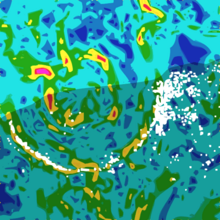Discovery[edit]
In 1978, geophysicists Antonio Camargo and Glen Penfield were working for the Mexican state-owned oil company Petróleos Mexicanos, or Pemex, as part of an airborne magnetic survey of the Gulf of Mexico north of the Yucatán peninsula.[8] Penfield's job was to use geophysical data to scout possible locations for oil drilling.[9] In the data, Penfield found a huge underwater arc with "extraordinary symmetry" in a ring 70 km (40 mi) across.[3] He then obtained a gravity map of the Yucatán made in the 1960s. A decade earlier, the same map suggested an impact feature to contractor Robert Baltosser, but he was forbidden to publicize his conclusion by Pemex corporate policy of the time.[10] Penfield found another arc on the peninsula itself, the ends of which pointed northward. Comparing the two maps, he found the separate arcs formed a circle, 180 km (111 mi) wide, centered near the Yucatán village Chicxulub; he felt certain the shape had been created by a cataclysmic event in geologic history.
Pemex disallowed release of specific data but let Penfield and company official Antonio Camargo present their results at the 1981 Society of Exploration Geophysicistsconference.[11] That year's conference was underattended and their report attracted scant attention. Coincidentally, many experts in impact craters and the K–Pg boundarywere attending a separate conference on Earth impacts. Although Penfield had plenty of geophysical data sets, he had no rock cores or other physical evidence of an impact.[9]
He knew Pemex had drilled exploratory wells in the region. In 1951, one bored into what was described as a thick layer of andesite about 1.3 km (4,200 ft) down. This layer could have resulted from the intense heat and pressure of an Earth impact, but at the time of the borings it was dismissed as a lava dome — a feature uncharacteristic of the region's geology. Penfield tried to secure site samples, but was told such samples had been lost or destroyed.[9] When attempts at returning to the drill sites and looking for rocks proved fruitless, Penfield abandoned his search, published his findings and returned to his Pemex work.
At the same time, scientist Luis Walter Alvarez put forth his hypothesis that a large extraterrestrial body had struck Earth and, unaware of Penfield's discovery, in 1981 University of Arizona graduate student Alan R. Hildebrand and faculty adviser William V. Boynton published a draft Earth-impact theory and sought a candidate crater.[12] Their evidence included greenish-brown clay with surplusiridium containing shocked quartz grains and small weathered glass beads that looked to be tektites.[13] Thick, jumbled deposits of coarse rock fragments were also present, thought to have been scoured from one place and deposited elsewhere by a kilometres-high tsunami resulting from an Earth impact.[14] Such deposits occur in many locations but seem concentrated in the Caribbean basin at the K–Pg boundary.[14] So when Haitian professor Florentine Morás discovered what he thought to be evidence of an ancient volcano on Haiti, Hildebrand suggested it could be a telltale feature of a nearby impact.[15] Tests on samples retrieved from the K–Pg boundary revealed more tektite glass, formed only in the heat of asteroid impacts and high-yield nuclear detonations.[15]
In 1990, Houston Chronicle reporter Carlos Byars told Hildebrand of Penfield's earlier discovery of a possible impact crater.[16] Hildebrand contacted Penfield in April 1990 and the pair soon secured two drill samples from the Pemex wells, stored in New Orleans.[17] Hildebrand's team tested the samples, which clearly showed shock-metamorphicmaterials.
A team of California researchers including Kevin Pope, Adriana Ocampo, and Charles Duller, surveying regional satellite images in 1996, found a sinkhole (cenote) ring centered on Chicxulub that matched the one Penfield saw earlier; the sinkholes were thought to be caused by subsidence of the impact crater wall.[18] More recent evidence suggests the actual crater is 300 km (190 mi) wide, and the 180 km ring is in fact an inner wall of it.[19]


No comments:
Post a Comment